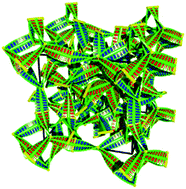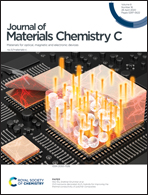Spontaneously chiral cubic liquid crystal: three interpenetrating networks with a twist†
Abstract
A new molecular-level model is proposed for the “Smectic-D” liquid crystal whose structure has remained controversial since the 1960s. The phase has a body-centred cubic lattice, and all previous structural models assumed an Im![[3 with combining macron]](https://www.rsc.org/images/entities/char_0033_0304.gif) m space group. However, this contradicts the recent discovery that the phase is always chiral, even in non-chiral compounds. The new model has the non-centrosymmetric space group I23, and consists of three interpenetrating networks, with 3-way planar network junctions like in the double gyroid phase. Rafts of 3–4 parallel molecules stack with an 8° twist on top of each other, forming spontaneously chiral columnar network segments. Homochirality throughout the network is enforced by matching the helical sense of all confluent segments at junctions. The findings indicate that coordinated helicity, previously unrecognized, is a key driving force responsible for the formation of a number of chiral and achiral, cubic and non-cubic bicontinuous phases of rod-like molecules.
m space group. However, this contradicts the recent discovery that the phase is always chiral, even in non-chiral compounds. The new model has the non-centrosymmetric space group I23, and consists of three interpenetrating networks, with 3-way planar network junctions like in the double gyroid phase. Rafts of 3–4 parallel molecules stack with an 8° twist on top of each other, forming spontaneously chiral columnar network segments. Homochirality throughout the network is enforced by matching the helical sense of all confluent segments at junctions. The findings indicate that coordinated helicity, previously unrecognized, is a key driving force responsible for the formation of a number of chiral and achiral, cubic and non-cubic bicontinuous phases of rod-like molecules.

- This article is part of the themed collection: 2020 Journal of Materials Chemistry C most popular articles


 Please wait while we load your content...
Please wait while we load your content...